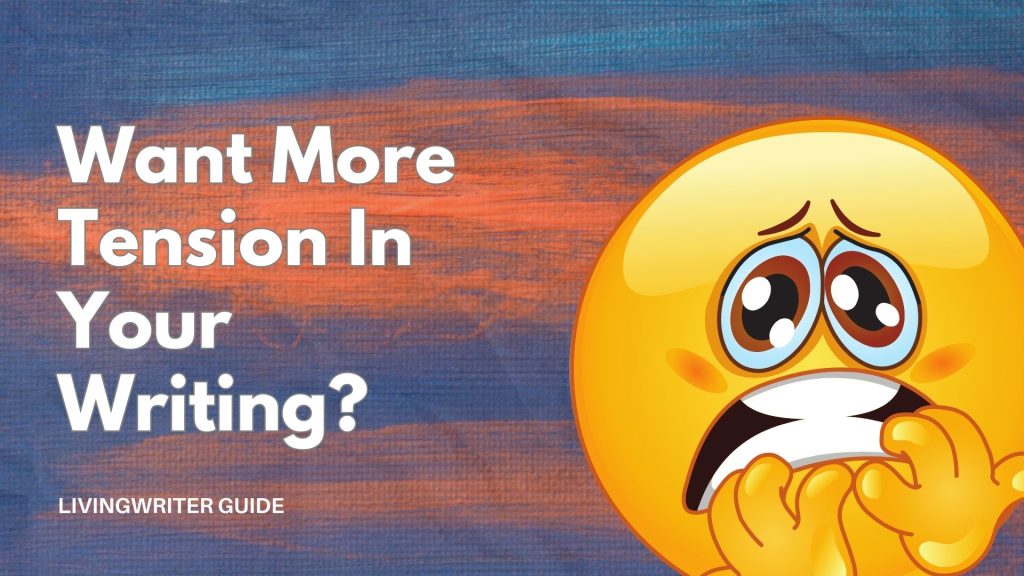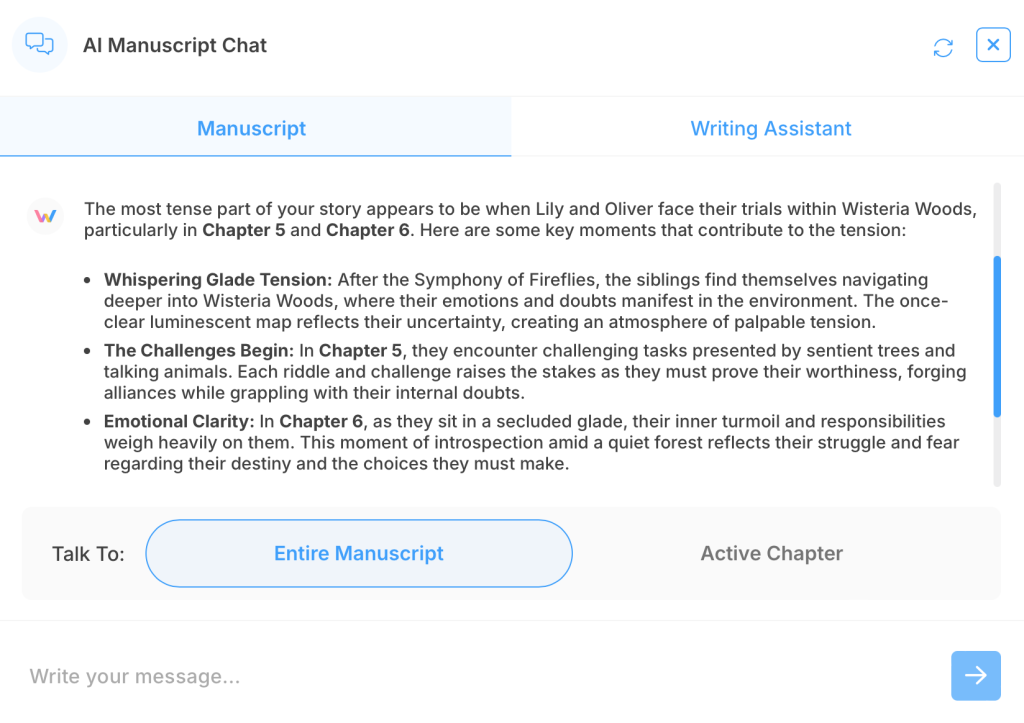Tension In Writing – A Complete 2025 Guide

Tension is an absolutely crucial element to good storytelling. At the end of the day, tension is what keeps readers interested in your story. Without tension, even the best plot, characters, and technical writing aren’t enough. Today I’ll be doing a deep dive into tension in writing and give you everything you need to know to take your writing to the next level.
This is a complete guide, so I’ll cover what tension is, why it matters in writing, techniques to add tension to every page of your stories, some must-know tips and tricks, and much more. Without further ado, let’s dive into everything you need to know about tension in writing.
Table Of Contents
A Guide To Tension In Writing
What Is Tension?
Just so we’re on the same page, let’s start by establishing what tension is and what it means in the context of a story. So, what is tension? Tension is the feeling that something significant, usually negative, is going to happen. It’s a sense of unease, worry, or pressure about a present-time, stressful situation.
Tension Vs. Suspense
It’s important to make the distinction between tension and suspense. While these feelings are similar (and you need both), they have some key differences in terms of storytelling. Here is a quick breakdown of each, followed by an example.
- Tension is being on edge about some particular element (that hasn’t actually happened yet) of a situation that is currently happening.
- Suspense is a foreboding feeling of anticipation about something possibly happening in the future that grows with time. It often has an element of the unknown.
In my experience, writers are well aware that they need suspense in their book. If you can make the reader wonder what’s going to happen, they’ll keep reading. But that resolution likely won’t happen until the end of the book. After all, suspense needs time to build. So, what happens in the meantime?
Usually, an ongoing, ever-escalating series of conflicts. Things that are happening and resolving in the present and act like small, exciting stepping stones that slowly but surely bring you to the big resolution. In general, this is exactly what you want to be doing.
You May Also Like: How To Best Use Cussing In Your Novel – 8 Tips
Conflict is happening in the present and building up to what’s going to happen later. Tension is a magical middle-ground where readers are right in the midst of a situation and are uncertain about the immediate outcome.
Tension Example
Whatever thing you’re worried about hasn’t happened yet, but you’re actively in a situation where it might. For example, say you get pulled over by the police with a body in the trunk and they’re suspicious.
You’ve not been caught yet… But if you make one wrong move, you will be. Answering the cop’s questions is going to be tense. You’re actively in the situation, but the outcome you fear still hangs in the balance.
Suspense Example
Suspense is a more drawn-out sense of worry about things that are not currently happening. In other words, it’s an anticipation about what will happen in the future. Using our example from above, pretend you’re the accomplice of the person with the body in the trunk. He told you to clean up while he gets rid of the body – That he’ll be back by midnight.
Well, it’s 1 AM now and you haven’t heard anything. You’d undoubtedly be in suspense. You don’t know that they’ve been caught, but you don’t know they haven’t either. And you’re terrified that they might have. Suspense is focused on the future and the unknown and builds as time goes on.
You probably didn’t start to worry at five past midnight. But once you do start to worry and wonder what’s happened (because surely something happened), that feeling will grow more and more intense with every passing minute.
Tension In Writing – 6 Key Tips
We now have a clear idea of what tension in writing is – A sense of uncertainty and anticipation about what might happen next within the present moment of your narrative. Here is what can you do to effectively create tension and pull your readers into the immediate struggles and uncertainties of the characters.
Raise The Stakes
Clearly define what your characters stand to gain or lose in a current situation. The higher the potential reward or the more devastating the possible consequences, the greater the inherent tension. Make these stakes personal and meaningful to your characters.

For another example, say a character is struggling to make enough in their current situation. If they were forced to take full-custody of their child all of a sudden, well, now paying the bills is not only harder but more important too.
Raising the stakes doesn’t usually create tension by itself in a given section. However, without clearly stating the highly important stakes, you won’t have a foundation to build individually tense scenes.
Introduce Obstacles And Challenges
Don’t make things easy for your characters. Throw roadblocks in their path, create complications, and present seemingly insurmountable challenges within the scene. The struggle to overcome these obstacles will naturally generate tension.
Going back to our example of someone with a body in the trunk of their car – Maybe they get lost. Or they get a flat tire. At that moment, this “small” hiccup will feel bigger than the body itself, and that is a beautiful thing. Layers of complex problems are your friend when writing tension.
Create Time Constraints
Another way to add pressure is by imposing deadlines or time limits on your characters’ actions. Whether it’s a ticking clock, a looming deadline, or a rapidly approaching threat, time constraints force characters into urgent action and heighten reader anxiety.
This can be used in conjunction with many of the things I’ve already mentioned. For example, if the car with the body in the trunk was borrowed, the characters would have to have their dirty deeds done in time to return it. This alone is an escalating factor… But it also makes getting lost or a flat tire even more important.
Withhold Information
Don’t reveal everything at once. Strategic withholding of key details, character motivations, or the true nature of the threat can create a sense of unease and keep readers guessing. When the stakes are high and they legitimately don’t have enough info to know what to expect, you’ve got a recipe for success.
You May Also Like: How To Write Like Gillian Flynn
Focus on Sensory Details
We all know what it feels like to be in a highly tense moment. This torturous space between fight or flight is an uncomfortable purgatory where neither action feels fully safe. When this happens, a lot goes on with your body – Engage the reader’s senses with these palpable details.
Describe the tightening in a character’s chest, the tremor in their voice, the redness of their face, their sudden sweat, or the oppressive silence as they grapple with how to respond to something.
Vary Pacing
There is an element of relative suddenness with tension. Sure, it can build, but on a long enough timeline, it becomes more of a suspense. Tension is in the moment (but unfulfilled), and suspense is wondering about the more distant future.
Alternating between some moments with a higher pace is a good way to introduce sudden tension. This can be done by using shorter sentences, visceral language, and short, snappy internal monologue. For more in-depth info on this, check out my article on Mastering Pacing In Novels And Screenplays.
How To Write Tension Without Action
Now that we have a clear idea of what tension is, let’s look at some tips for injecting it into your writing. First, remember that tension is present in the moment (but hasn’t happened yet) when you write scenes. Beyond this, you can add tension on any page, even without action, by using conflicting, often internal emotions.
I’ll show you exactly what I mean and give some examples of how well it works compared to using a single emotion.
Using Conflicting Emotions
Rarely in life are many situations 100% good, bad, etc, and nothing else. Therefore, instead of relying on a single, straightforward emotion, in your fiction, consider layering your characters’ situations too. This mirroring of life’s complexities can add a dose of tension into your narrative, even in moments devoid of external action. The reader feels the character’s precarious emotional state.
Let’s start with a scene with a single emotion involved and then add some juxtaposition and see the difference in tension.
Example 1 – Waiting for a Verdict
Single Emotion (Anxiety)
“Maria sat in the courtroom, her hands clenched tightly in her lap. Every rustle of paper, every hushed whisper from the jury box amplified her worry. She just wanted to know the verdict and escape this suffocating feeling of dread.”
Here we have a scene with a woman in court, anxious about the verdict. With some context and investment in the characters, a writer may assume this description or worry will make the reader worry too. While the plot may heighten the feeling some, using only anxiety leaves something to be desired. Let’s rewrite it with a secondary emotion too.
Conflicting Emotions (Hope + Anxiety)
“Maria sat in the courtroom, her knuckles white against the worn fabric of her skirt. A fragile hope flickered within her, a desperate plea for a favorable outcome, battling the crushing fear of the alternative. Each prolonged silence from the jury box tightened the knot of anxiety in her chest, yet a stubborn refusal to accept defeat kept a sliver of optimism alive.”
In this second version, we have the same scenario – A woman sitting in court, anxious about the verdict. However, this time we touch on hope too. How much she hopes the verdict goes the way she wants. She is anxious because it might not. This creates a situation where we know something is at stake in this very moment and adds substantially more tension.
Example 2: Approaching a Dangerous Place
Single Emotion (Fear)
“He walked down the dark alley, feeling scared. The shadows seemed to reach out, and every sound made him jump. He knew he shouldn’t be here, and the feeling of danger grew with each step. Yet, he pushed forward, looking for the answers that he had to find.”
In this passage, the emotion is fear. Again, assuming you’ve got some context around this section, it’s easy to think that talking about your character’s fear will make readers wonder what lurks in the darkness. Let’s try the same passage with an added emotion.
Conflicting Emotions (Fear + Determination)
“A knot of apprehension tightened in Ben’s stomach as he entered the mouth of the alley, the darkness swallowing the last vestiges of daylight. Yet, a stubborn determination propelled him forward, overriding the primal fear that prickled his skin. He dreaded what he might find, but a desperate drive for answers spurred him deeper into the shadows.”
In this version, instead of only fear, we also see determination. Yes, Ben is scared, but whatever answer he’s looking for is so important that he’s willing to ignore it. This adds another element to the scene and lets the reader know that whatever hidden info lies beyond is worth the negative emotions.
Writing Tension With LivingWriter
If you’re looking to instantly level up your ability to do tension in writing, LivingWriter is what you want. Before you start to “fix” your tense sections, wouldn’t it be nice to know where you stand? With LivingWriter’s Manuscript Chat features, you can get a feel for where you stand with your tension.
This is your go-to tool for any question related to your manuscript, and I do mean any question. It can answer theoretical questions about your plot or characters, research-based questions, and how to induce a certain feeling (in this case, tension) into a passage.
To start, I asked the chat (which is familiar with my individual story), “What is the most tense part of my story?” And here is what I got:

The chat has directly pinpointed the highest moment of tension in my story. Unfortunately, it doesn’t happen until chapters 5 and 6. Knowing there is little tension in chapters 1-4 gives valuable insight into which sections are weak and where to point your efforts. Now, let’s actually make it better. I asked, “How can I add more tension to chapters 1-4 without adding extra action?” and here is what I got.
To enhance tension in Chapters 1-4 without adding extra action, consider the following strategies:
1. Internal Conflict
– Deepen Lily and Oliver’s internal struggles. Highlight their fears and doubts about leaving their comfort zone, which creates emotional weight. For instance, Lily might fear disappointing her peers or Oliver could worry about the unknown dangers of Wisteria Woods.2. Foreshadowing
– Introduce subtle hints of impending trouble or mysteries. Subtle shadows in their dreams or strange occurrences around Hearthglen can imply that adventure isn’t just about excitement, but may have darker undertones.3. Sensory Details
– Use rich sensory descriptions to evoke unease. Paint the environment with unsettling details, such as the creeping fog around the oak tree or whispers of the woods that unsettle them, causing their skin to prickle.4. Increasing Stakes
– Introduce limits or deadlines that imply urgency. For example, if the map has a limited amount of time before it loses its magic, it would press Lily and Oliver into a decision-making corner that heightens tension.5. Character Relationships
– Explore tension in their sibling relationship. Perhaps they disagree on whether to pursue the adventure, leading to strained moments that simmer underneath their excitement.6. Symbolic Elements
– Use the enchanted map or the attic tome as symbols that forebode potential danger. Construe momentswhere these items react oddly, giving hints that their journey might not be as benign as they believe.7. Unresolved Questions
– Create unanswered questions that gnaw at them. Hints of a legacy or backstory associated with Wisteria Woods can keep the characters and readers on edge, wondering what lies ahead.By weaving these elements throughout Chapters 1-4, you can build a palpable sense of tension without relying solely on action.
The beauty of LivingWriter’s AI is that it offers you feedback tailored to your specific story, and that it doesn’t write for you. So, you don’t have to worry about generic advice or lifeless writing. Instead, you get specialized, actionable advice to help you do your best writing and learn from your mistakes.
Voted the best writing app of 2025 – From better tension to story outlines to more unique characters, LivingWriter helps you reach your full potential.